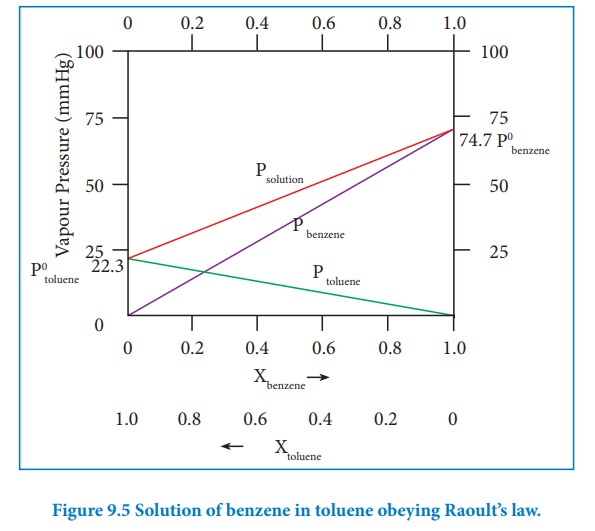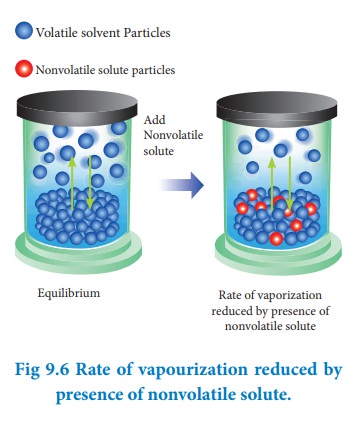Chemistry - Vapour pressure of liquid solutions | 11th Chemistry : UNIT 9 : Solutions
Chapter: 11th Chemistry : UNIT 9 : Solutions
Vapour pressure of liquid solutions
Vapour
pressure of liquid solutions
When
a solute (of any physical state - solid, liquid or gas ) is dissolved in a
liquid solvent the resultant solution is called a liquid solution. The solution
which contains only two components (one solvent and one solute) is called a
binary solution. We have already discussed the solution of a gaseous solute in
liquid solvent under Henry's law.
Vapour pressure of binary solution of liquid in liquids
Now, let us consider a binary liquid solution formed by dissolving a liquid solute ŌĆśAŌĆÖ in a pure solvent ŌĆśBŌĆÖ in a closed vessel. Both the components A and B present in the solution would evaporate and an equilibrium will be established between the liquid and vapour phases of the components A and B.
The
French chemist Raoult, proposed a quantitative relationship between the partial
pressures and the mole fractions of two components A & B, which is known as
RaoultŌĆÖs Law. This law states that ŌĆ£in the case of a solution of volatile
liquids, the partial vapour pressure of each component (A & B) of the
solution is directly proportional to its mole fractionŌĆØ.
According to RaoultŌĆÖs law,
pA╬▒ xA (9.3)
pA = k xA
when
xA = 1, k = p┬░A
where
p┬░A is the vapour pressure of pure component ŌĆśAŌĆÖ at the same
temperature.
Therefore,
pA = p┬░AXA (9.4)
Similarly, for
component ŌĆśBŌĆÖ
pB= p┬░B xB (9.5)
xA
and xB are the mole fraction of the components A and B respectively.
According
to DaltonŌĆÖs law of partial pressure the total pressure in a closed vessel will
be equal to the sum of the partial pressures of the individual components.
Hence,
Ptotal = pA + pB (9.6)
Substituting
the values of pA and pB from equations (9.4) and (9.5) in
the above equation,
Ptotal = xAp┬░A + xBp┬░B
(9.7)
We
know that xA + xB = 1 or xA = 1 - xB
Therefore,
Ptotal = (1 - xB) p┬░A + xB
p┬░B (9.8)
Ptotal= p┬░A + xB( p┬░B-
p┬░A)
(9.9)
The
above equation is of the straight-line equation form y = mx+c. The plot of Ptotal
versus xa will give a straight line with (pB┬░- pA┬░)
as slope and pA┬░ as the y intercept.
Let
us consider the liquid solution containing toluene (solute) in benzene
(solvent).
The
variation of vapour pressure of pure benzene and toluene with its mole fraction
is given in the graph.

The
vapour pressures of pure toluene and pure benzene are 22.3 and 74.7 mmHg,
respectively. The above graph shows, the partial vapour pressure of the pure
components increases linearly with the increase in the mole fraction of the
respective components. The total pressure at any composition of the solute and
solvent is given by the following straight line (represented as red line)
equation.

Vapour pressure of binary solution of solids in liquids
When
a nonvolatile solute is dissolved in a pure solvent, the vapour pressure of the
pure solvent will decrease. In such solutions, the vapour pressure of the
solution will depend only on the solvent molecules as the solute is
nonvolatile.
For
example, when sodium chloride is added to the water, the vapour pressure of the
salt solution is lowered. The vapour pressure of the solution is determined by
the number of molecules of the solvent present in the surface at any time and
is proportional to the mole fraction of the solvent.

Psolution
ŌłØxA (9.11)
Where
xA is the mole fraction of the solvent
Psolution = k xA (9.12)
When xA = 1, K = Posolvent
(Psolvento
is the partial pressure of pure solvent)
Psolution = Posolvent
xA (9.13)

Where
xB is the fraction of the solute
(Ōł┤ xA + xB = 1, xB = 1 - xA)
The
above expression gives the relative lowering of vapour pressure. Based on this
expression, RaoultŌĆÖs Law can also be stated as ŌĆ£the relative lowering of vapour
pressure of an ideal solution containing the nonvolatile solute is equal to the
mole fraction of the solute at a given temperatureŌĆØ.
![]()
![]()
Comparison of RaoultŌĆÖs law and HenryŌĆÖs law
According
to RaoultŌĆÖs law, for a solution containing a nonvolatile solute
psolute = p┬░solutexsolute (9.17)
According
to HenryŌĆÖs law:
psolute = KHxsolute in solution (9.18)
The
difference between the above two expressions is the proportionality constant p┬░A
(Raoults Law) and KH .(Henry's Law). Henry's law is applicable to
solution containing gaseous solute in liquid solvent, while the Raoults Law is
applicable to nonvolatile solid solute in a liquid solvent. If the solute is
non volatile then the Henry's law constant will become equal to the vapour of
the pure solvent (p┬░) and thus, RaoultŌĆÖs law becomes a special Acase
of HenryŌĆÖs law. For very dilute solutions the solvent obeys RaoultŌĆÖs law and
the solute obeys HenryŌĆÖs law.
Related Topics